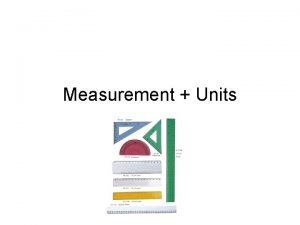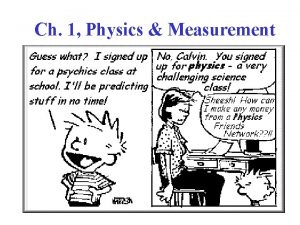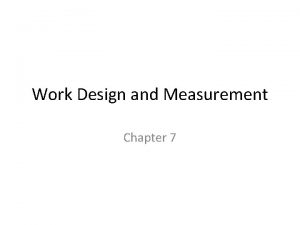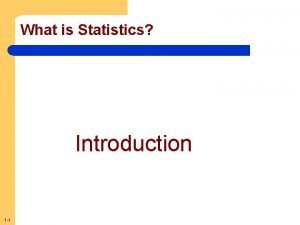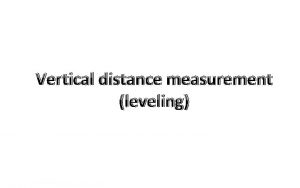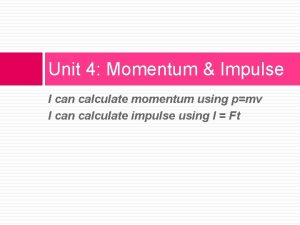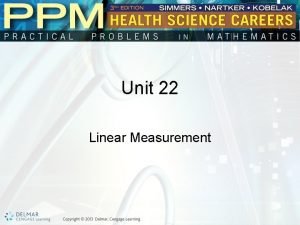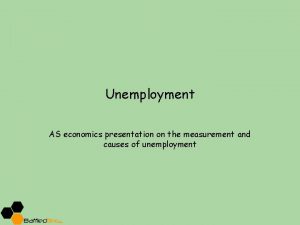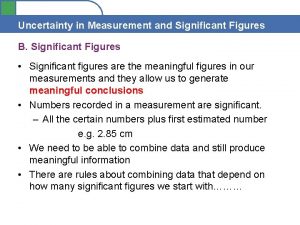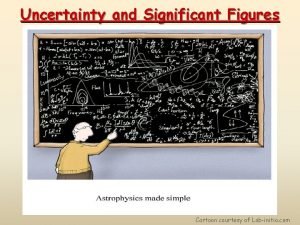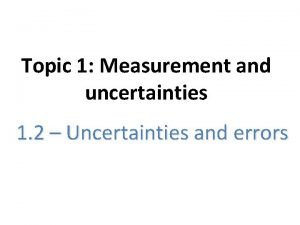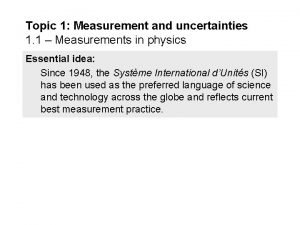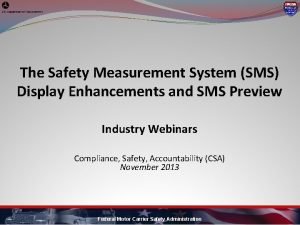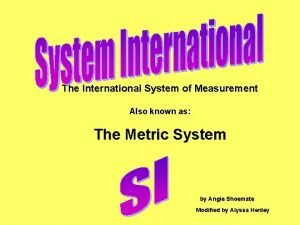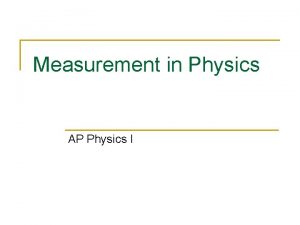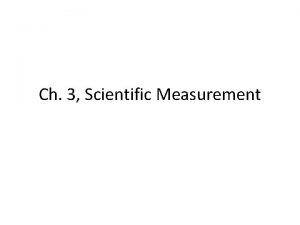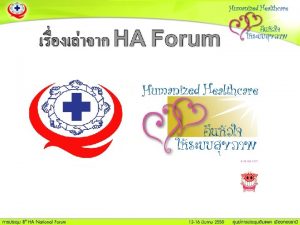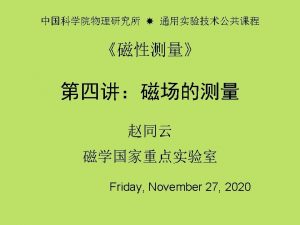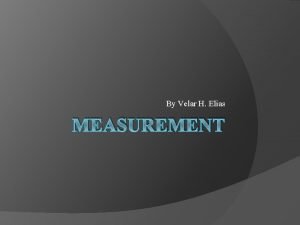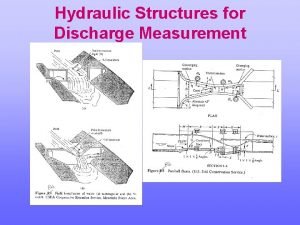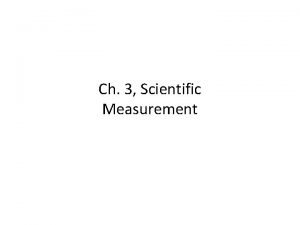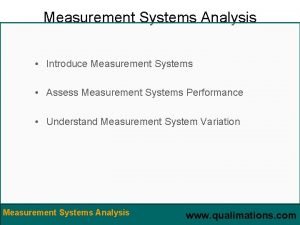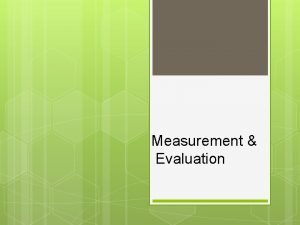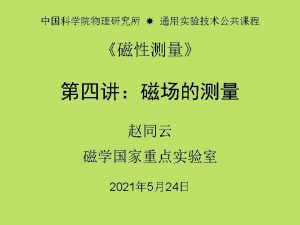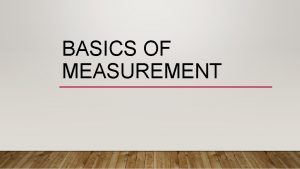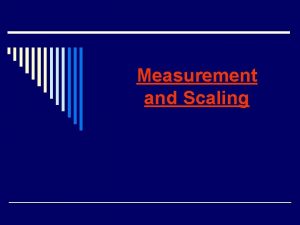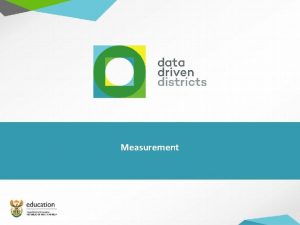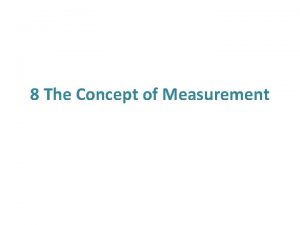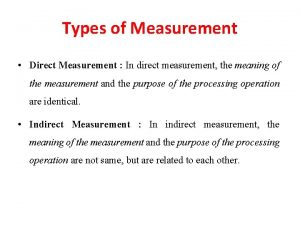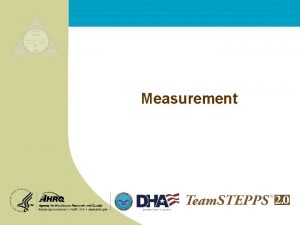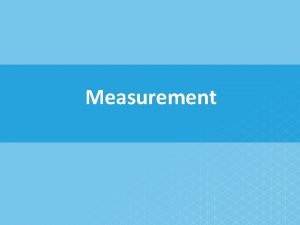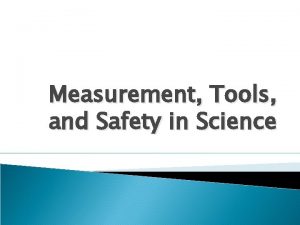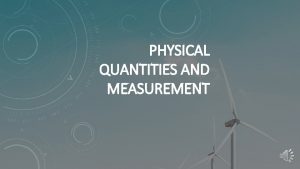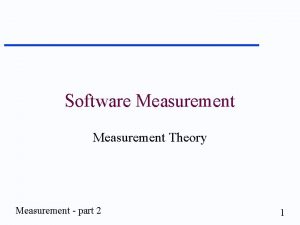Ch 1 Physics Measurement Outline Ch 1 Physics


























- Slides: 26

Ch. 1, Physics & Measurement

Outline Ch. 1, Physics & Measurement 1. Physics is an experimental science Measurements Units 2. Physics is a quantitative science Mathematics Algebra & Calculus 3. International System (SI) of units: Length m, Time s, Mass kg Objects have different sizes Conversion of units 4. Other properties of matter require the use of derived units: ρ = m/V density unit: kg/m 3 If you know the formula You can find the units If you know the units You can “guess” the formula!

Physics: The most basic of all sciences! • Physics: The “Mother” of all sciences! • Physics = The study of the behavior of and the structure of matter and energy and of the interaction between matter and energy.

Sub Areas of Physics • This course (1408, Physics of 16 th & 17 th Centuries): – Motion (MECHANICS) (most of our time!) – Fluids & Waves • Next course (2401, Physics of 18 th & 19 th Centuries): – Electricity & magnetism – Light & optics • Advanced courses (Physics of the 20 th Century!): – Relativity, atomic structure, condensed matter, nuclear physics, …. – These are the most interesting & the most relevant to modern technology!

Physics: General Discussion • Goal of Physics (& all of science): To quantitatively and qualitatively describe the “world around us”. • Physics IS NOT merely a collection of facts and formulas! • Physics IS a creative activity! • Physics Observation Explanation. • Requires IMAGINATION!!

Physics & its relation to other fields • The “Mother” of all Sciences! • The foundation for and is connected to ALL branches of science and engineering. • Also useful in everyday life and in MANY professions – Chemistry – Life Sciences – Architecture – Engineering. – ….

Theory • Quantitative description of experimental observations. • Not just WHAT is observed but WHY it is observed as it is and HOW it works the way it does. • Tests of theories: – Experimental observation: More experiments, more observation. – Predictions: Made before observations & experiments.

Model, Theory, Law • Model: An analogy of a physical phenomenon to something we are familiar with. • Theory: More detailed than a model. Puts the model into mathematical language. • Law: Concise & general statement about how nature behaves. Must be verified by many, many experiments! Only a few laws. – Not comparable to laws of government!

Measurement & Uncertainty • Physics is an EXPERIMENTAL science! – Finds relations between physical quantities. – Expresses those relations in the language of mathematics. (LAWS & THEORIES) • Experiments are NEVER 100% accurate. – Always have uncertainty in final result. • Experimental error. – Common to state this precision (when known).

• Consider a simple measurement of the width of a board. Find 23. 2 cm. • However, measurement is only accurate to 0. 1 cm (estimated). Write width as (23. 2 0. 1) cm 0. 1 cm Experimental uncertainty • Percent Uncertainty: (0. 1/23. 2) 100 0. 4%

Significant Figures • Significant figures (“sig figs”) The number of reliably known digits in a number. • Calculation involving several numbers. – Number of sig figs in result Number of sig figs of the number containing the smallest number of sig figs which entered the calculation.

• Example: (Not to scale!) – Area of board, dimensions 11. 3 cm 6. 8 cm – Area = (11. 3) (6. 8) = 76. 84 cm 2 11. 3 has 3 sig figs , 6. 8 has 2 sig figs 76. 84 has too many sig figs! – Proper number of sig figs in answer = 2 Round off 76. 84 & keep only 2 sig figs Reliable answer for area = 77 cm 2

Sig Figs • General Rule: Final result of multiplication or division should have only as many sig figs as the number with least sig figs in the calculation. • NOTE!!!! All digits on your calculator are NOT significant!!

Powers of 10 (Scientific Notation) • READ Appendix B. 1 • Common to express very large or very small numbers using powers of 10 notation. • Examples: 39, 600 = 3. 96 104 (moved decimal 4 places to left) 0. 0021 = 2. 1 10 -3 (moved decimal 3 places to right)

Units, Standards, SI System • All measured physical quantities have units. • Units are VITAL in physics!! • In this course (and in most of the modern world, except the USA!) we will use (almost) exclusively the SI system of units. SI = “Systéme International” (French) More commonly called the “MKS system” (meter-kilogram-second) or more simply, “the metric system”

SI or MKS System • Defined in terms of standards for length, mass (we’ll discuss later), and time. • Length unit: Meter (m) (kilometer = km = 1000 m) – Standard meter. Newest definition in terms of speed of light Length of path traveled by light in vacuum in (1/299, 792, 458) of a second! • Time unit: Second (s) – Standard second. Newest definition time required for 9, 192, 631, 770 oscillations of radiation emitted by cesium atoms! • Mass unit: Kilogram (kg) – Discussed in detail later

Larger & smaller units defined from SI standards by powers of 10 & Greek prefixes

Typical Lengths (approx. )

Typical Times & Masses (approx. )

Other Systems of Units • CGS (centimeter-gram-second) system – Centimeter = 0. 01 meter – Gram = 0. 001 kilogram • British (foot-pound-second) system – Our “everyday life” system of units – Only used by USA and some third world countries. Rest of world (including Britain!) uses SI system. We will not use the British System in this course! – Conversions exist between the British & SI systems. We will not use them in this course!

In this class, we will NOT do unit conversions! We will work exclusively in SI (MKS) units!

Basic & Derived Quantities • Basic Quantity Must be defined in terms of a standard (meter, kilogram, second). • Derived Quantity Defined in terms of combinations of basic quantities – Unit of speed = meter/second = m/s

Units and Equations • In dealing with equations, remember that the units must be the same on both sides of an equation (otherwise, it is not an equation)! • Example: You go 90 km/hr for 40 minutes. How far did you go? – Equation from Ch. 2: x = vt, v = 90 km/hr, t = 40 min. To use this equation, first convert t to hours: t = (⅔)hr so, x = (90 km/hr) [(⅔)hr] = 60 km The hour unit (hr) has (literally) cancelled out in the numerator & denominator!

Changing Units • As in the example, units in the numerator & the denominator cancel out (as in algebra) • Illustration: Convert 80 km/hr to m/s Conversions: 1 km = 1000 m; 1 hr = 3600 s 80 km/hr = (80 km/hr) (1000 m/km) (1 hr/3600 s) (Cancel units!) 80 km/hr 22 m/s • Useful conversions: (22. 222…m/s) 1 m/s 3. 6 km/hr; 1 km/hr (1/3. 6) m/s

Order of Magnitude; Rapid Estimating • Sometimes, we are interested in only an approximate value for a quantity. We are interested in obtaining rough or order of magnitude estimates. • Order of magnitude estimates: Made by rounding off all numbers in a calculation to 1 sig fig, along with power of 10. – Can be accurate to within a factor of 10 (often better)

Example: V = πr 2 d • Example: Estimate!
 Example of topic outline and sentence outline
Example of topic outline and sentence outline Units of measurement in physics
Units of measurement in physics Chapter 1 physical quantities and measurement
Chapter 1 physical quantities and measurement General physics measurement
General physics measurement Chapter 1 physics and measurement
Chapter 1 physics and measurement Why does it happen
Why does it happen University physics with modern physics fifteenth edition
University physics with modern physics fifteenth edition Physics ia format
Physics ia format Write whether each
Write whether each Work measurement techniques
Work measurement techniques Level of measurement statistics
Level of measurement statistics Mr. gallon
Mr. gallon Weather measurement tools
Weather measurement tools Vertical
Vertical What is vertical distance in surveying
What is vertical distance in surveying Jvp waves
Jvp waves International measurement system
International measurement system Units of momentum physics
Units of momentum physics Units of linear measurement
Units of linear measurement Unemployment measures
Unemployment measures Uncertainty in measurement and significant digits
Uncertainty in measurement and significant digits Significant figures cartoon
Significant figures cartoon Uncertainty of slope
Uncertainty of slope Measurements and uncertainties ib physics
Measurements and uncertainties ib physics Safety measurement system
Safety measurement system International measurement system
International measurement system The customary system
The customary system

